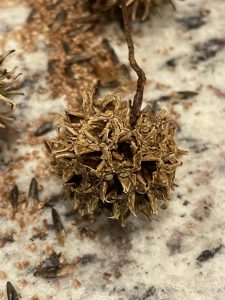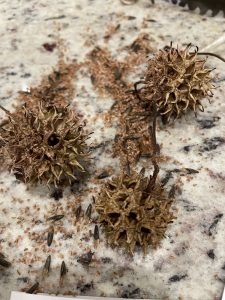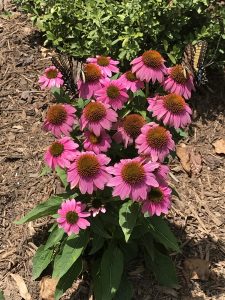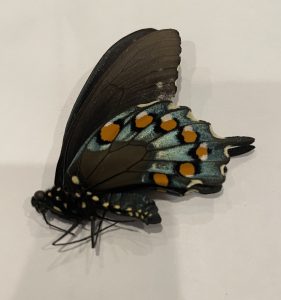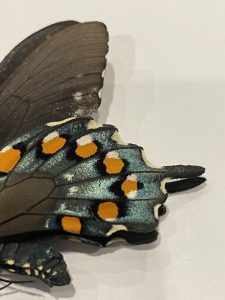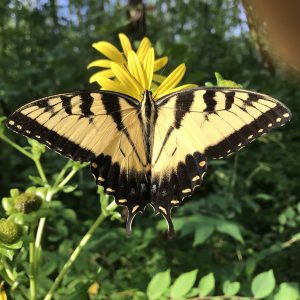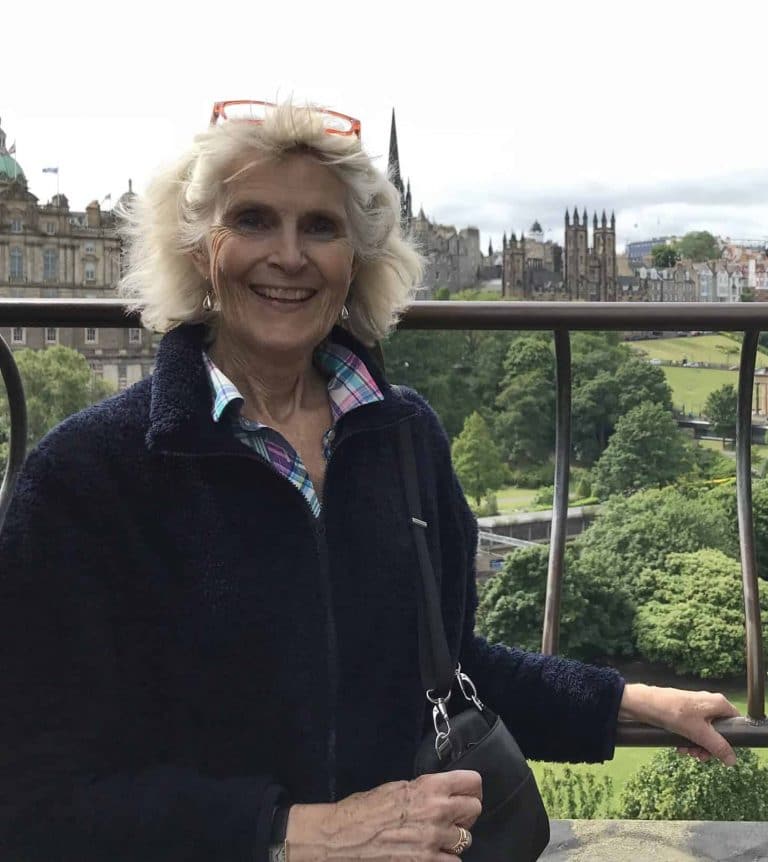My pathway in winter is strewn with seedpods of the sweet gum. Now many people complain about them, but I love their beauty and abundance. They seem to be scattered endlessly on the path and in the grass and woods. Their miniature seeds are mostly gone having emptied out of these little spikey satellites earlier in the season. Months ago, I brought two seedpods back to my house and let them sprinkle their seeds on my countertop. Hundreds of them. Given the right conditions, some of these seeds will grow into trees over a hundred feet high. They make up some of the tallest trees in the nature preserve.
As I examined this incredible work of art and creation, it struck me that each seed, flower, bird, butterfly and tree has a specific individual shape. Each keeps to its created form according to the intricate DNA specific to them. Take for instance the coneflower. There may be variations in color, texture and size of its petals, but over time they stay within the “boundaries” established of their form. Petals only get to a certain size. Longer petals don’t appear accidentally because the petal decided to grow to four inches instead of two. Color variations are slight. You don’t find a white petal among the pink. The size and flowering of a coneflower has stayed the same for years. Its form is encoded in it from the start of its very existence. That form is passed on to its seeds. This is the miracle of DNA.
The same idea is true of butterflies. If you look at a butterfly wing under a magnifying glass, you will see thousands of tiny cells that make up its wings. The offspring of this butterfly will have the same pattern. Yes there might be minute variation, but nothing that changes what type of butterfly it’s going to become. And in the case of butterflies, that genetic encoding is carried by the caterpillar also. Amazing!
When the Lord created the heavens and earth, the scripture says “the earth was without form, and void; and darkness was upon the face of the deep.”* What struck me when I read this was that the earth was formless. God created form.
This act of God is displayed every day as I walk in the forest. He made trees to grow from a trunk and most plants to grow from an upright stem, except of course for vines whose stem wanders. He made the animals distinct from each other but kept to a form of head with eyes, nose and mouth and bodies with legs or fins and tails. Of course, someone could argue that there are exceptions to this rule like amoebas or bacteria, but I submit that even these microscopic organisms keep to their original God breathed shape. Somehow, within the DNA of every life form, there are instructions on how to grow into its shape and size. We have hundreds of trees, but we recognize trees by their form. We easily distinguish a tree from a flower or racoon. Some of my favorite creatures are birds. Gods provision for them to fly puts their form in a class all to themselves.
The scripture doesn’t say much about God creating plants and animals. But it does say something startling when He created mankind. “Let us make man in our image, after our likeness.” Yes, the many parts of creation are uniquely God created and breathed with life. But only mankind is intended to be fashioned after the triune God’s likeness. That should tell you something about your place in His kingdom.
There is plenty of discussion about what it means to be made in His image and likeness. Quite frankly my study of the Hebrew words for image and likeness did not give me much to work with. But I’ll leave that for you to explore with the commentators. Since God is Spirit, it would seem that our likeness would be more spiritual than bodily form. We are born with a spirit that is made alive only by the Holy Spirit coming to dwell within us when we are born again. What else stands out is that we can know and communicate with God. Anything else that makes us like Him will be part of the wondrous things we’ll see when we enter heaven. He created us in His likeness and image. That’s good enough for me.
No matter how you look at it, human beings are distinct in God’s creation from everything else. We have our own shape and form, and we can reason. And like everything in all creation, we only attain a certain size. There is a finite number of hair and eye colors. Just as there is a finite number of colors on the color wheel that our eyes can see. It doesn’t mean that there aren’t other colors in heaven, only here.
This brings me back to the sweet gum seedpods. They only attain a certain size. They probably have a predetermined number of seeds inside of them just as they have a definite time to fall onto my pathway. So the next time you are outside walking, ponder the integrity of the forms that you see and thank Him for making everything so precisely structured and lovely.
“In the beginning God created the heavens and the earth. Now the earth was formless and empty, darkness was over the surface of the deep, and the Spirit of God was hovering over the waters.”
Genesis 1:1-2 NIV
*Genesis 1:1
